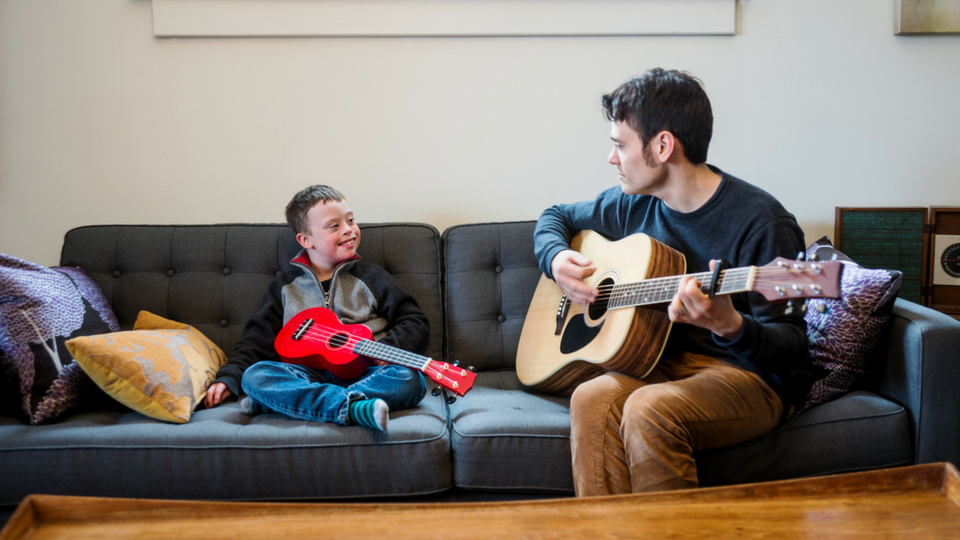Music Rehabilitation Therapy
Posted in

Music has long been perceived as relaxing and soothing through the centuries. However, just in recent years, the healing power of music has been scientifically studied and music therapy has gained traction as a reputable, effective and healing form of rehabilitation therapy.
Suzanne Heppel, board certified music therapist at INTEGRIS Jim Thorpe Rehabilitation, enjoys making a difference in the lives of her patients. “I love being able to be that bright light of hope and encouragement for people who have been through a very traumatic experience,” Heppel says. “I show them they still have the ability to produce beautiful music or movement they thought was lost with the injury.”
So, what is music therapy and why is it so effective in rehabilitation?
What is music therapy?
According to the American Music Therapy Association, music therapy is “the clinical and evidence-based use of music interventions to accomplish individualized goals within a therapeutic relationship by a credentialed professional who has completed an approved music therapy program.”
Like many other forms of rehabilitation therapy, music therapy is personalized to the patient’s needs, so sessions can vary greatly depending on the patient. “There are never two music therapy sessions that are the same,” Heppel says. “Everyone is different and so is the recommended music therapy for each person.”
Music therapists begin by assessing a patient through musical responses, which can tell them about the patient’s emotional and physical well-being, social functioning, communication abilities and cognitive skills. After the patient has been assessed, the therapist can then design a personalized session using the following activities.
- Musical improvisation
- Receptive music listening
- Song writing
- Lyric discussion
- Music and imagery
- Music performance
- Musical learning
These activities can be used to tackle a variety of issues, from the stress and anxiety experienced by terminally ill patients to the physical limitations of someone recovering from an injury, or even the social skills of a child with autism.
“Music therapy sessions can be a one-on-one setting with the patient, in the therapy room or at the bedside,” Heppel says. “There are also times when using music therapy in a group format is even better for encouraging initiation and interaction.”
Who can benefit from music therapy?
Because music therapy can be so diverse, there are a wide variety of people, injuries and conditions it can help.
Music therapy can provide benefits to people of all ages with “mental health needs, developmental and learning disabilities, Alzheimer's, substance abuse problems, brain injuries, physical disabilities, and acute and chronic pain, including mothers in labor,” Heppel says.
Music therapists work in a wide variety of facilities, including:
- Hospitals
- Rehabilitation facilities
- Outpatient clinics
- Day care treatment centers
- Agencies that serve people with developmental disabilities
- Community mental health centers
- Drug and alcohol programs
- Senior centers and nursing homes
- Hospice programs
- Correctional facilities
- Halfway houses
- Schools
- Private practices
At INTEGRIS Jim Thorpe Rehabilitation, Heppel works primarily with patients who have suffered a stroke, brain or spinal cord injury.
For a stroke patient, music therapy can not only improve mood and reduce stress levels, but can also elicit a physical response in the body to overcome aphasia. Aphasia is a common result of stroke that affects the patient’s ability to understand or express speech.
"Music therapy is able to bring about responses in people that the other disciplines of therapy cannot access," Heppel says. "For instance, a patient who has significant expressive aphasia will have extreme challenges communicating their wants and needs. When you use rhythm and melody, you provide the structure and form for that person to verbalize automatic responses and communication."
What qualifications does a music therapist need?
Practicing music therapists must earn a bachelor’s degree or higher in music therapy from an American Music Therapy Association program. In addition, they must also complete 1,200 hours of fieldwork, including an internship in health care or education facilities.
After obtaining their degree, music therapists are eligible to take the board certification exam to earn the Music Therapy - Board Certification credential, which qualifies them to practice. There are graduate and doctoral degrees available in music therapy, but these are not required in order to be a practicing music therapist.
Music therapy in Oklahoma
In 2016, House Bill 2820, which requires music therapists in Oklahoma to be licensed and regulated through the Oklahoma State Medical Licensure Board, was passed. Now called the Music Therapy Practice Act, this bill was written by Anne Roberts, director of legislative affairs at INTEGRIS, and Lee Denney. Roberts used real examples of music therapy successes from INTEGRIS Jim Thorpe Rehabilitation to prove the value of certified and regulated music therapists. After the bill passed, Denney and Roberts received the Music Therapy State Advocacy Award from the American Music Therapy Association.
At INTEGRIS, we’re proud to be at the forefront of medicine, offering the very best in integrative therapies to Oklahomans in need. Our music therapists, like Suzanne Heppel, are board certified and give our patients personalized care to meet their specific needs. To learn more about our rehabilitation therapies, visit Jim Thorpe Rehabilitation.

